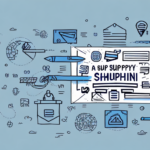Understanding the Basics of Bill of Lading (BOL or B/L) in Supply Chain Management
If you are involved in the logistics industry, you have probably heard of a Bill of Lading (BOL or B/L). But what exactly is it, and why is it important in supply chain management? In this article, we will explore the fundamentals of B/L, its different types, legal nature, role in international trade, preparation steps, and more.
What is a Bill of Lading (BOL or B/L) and Why is it Important in Supply Chain Management?
A Bill of Lading (B/L) is a document issued by a carrier (such as a shipping line, trucking company, or airline) that serves as a receipt, contract, and title deed for the goods being transported. It confirms that the goods have been received by the carrier, details their quantity and condition, and outlines the terms and conditions of transportation.
B/L is crucial in supply chain management for several reasons:
- Transfer of Ownership and Liability: It enables the transfer of ownership and liability for the goods from the seller to the buyer.
- Proof of Delivery: It serves as evidence in case of disputes, loss, or damage.
- Information Provision: It provides vital information about the shipment to stakeholders such as customs, banks, insurers, and other parties involved in the trade transaction.
Furthermore, the B/L plays a pivotal role in international trade by complying with the regulations of the country of origin, destination, and any transit countries. It includes information about the type of goods, their value, and their destination, which is essential for customs clearance and compliance with trade agreements and tariffs. Without a proper B/L, shipments may face delays, rejection, or penalties. Therefore, it is essential for supply chain managers to ensure that the B/L is accurate, complete, and issued promptly to avoid disruptions or legal issues.
The Legal Nature of Bill of Lading (BOL or B/L): Explained
B/L is a legally binding document that establishes rights and obligations between the carrier, shipper, and consignee (the party receiving the goods). It is considered a negotiable instrument, meaning it can be transferred or endorsed by the holder, granting them the right to receive the goods.
A Straight or Non-Negotiable B/L allows goods to be released only to the named consignee, who must present it along with other documents (such as an invoice, packing list, and certificate of origin) to clear the goods through customs and take possession. In contrast, a Negotiable or Order B/L allows goods to be delivered to anyone who possesses it, either the named consignee or any other holder who has acquired it by endorsement or transfer.
The legal status of a B/L can vary depending on jurisdiction and contract terms. In some countries, a B/L is considered a document of title, granting legal ownership and the ability to transfer ownership to another party. In others, it may only serve as a receipt for the goods, without conferring ownership or transferable rights. Understanding the legal implications in the relevant jurisdictions is crucial to avoid disputes or legal complications.
Different Types of Bill of Lading (BOL or B/L) and Their Uses
There are several types of B/L, each with its specific characteristics and uses:
- Straight Bill of Lading: Non-negotiable, allowing delivery only to the named consignee.
- Order Bill of Lading: Negotiable, can be transferred or endorsed to other parties.
- Bearer Bill of Lading: Negotiable without requiring endorsement; whoever holds it can claim the goods.
- Charter Party Bill of Lading: Issued by the charterer of a vessel, outlining the terms of the charter party agreement between the shipowner and charterer.
- Multimodal Bill of Lading: Covers multiple modes of transport (sea, land, air) and their respective carriers.
Each type of B/L offers different advantages and is chosen based on the specific requirements of the trade transaction, parties involved, and the nature of the goods being shipped.
Bill of Lading (BOL or B/L) vs. Sea Waybill: What's the Difference?
A Sea Waybill is similar to a B/L but functions primarily as a non-negotiable receipt and contract for the goods being shipped, rather than a title deed. It does not transfer ownership or liability and can be issued and transmitted electronically, eliminating the need for physical copies.
The main differences between B/L and Sea Waybill are:
- Negotiability: B/L is negotiable, whereas Sea Waybill is not.
- Physical Presentation: B/L requires physical surrender to release goods; Sea Waybill does not.
- Collateral Use: B/L can be used as collateral for financing; Sea Waybill cannot.
The Role of Bill of Lading (BOL or B/L) in International Trade
B/L is integral to international trade, serving as a key document in the export/import process. It contains information about the shipper, consignee, goods, carrier, voyage, and payment terms. It is used to:
- Instruct the carrier on delivery details.
- Clear goods through customs and obtain necessary permits and licenses.
- Arrange payment of freight charges and other fees.
- Secure financing and facilitate the transfer of title and ownership.
B/L is governed by international conventions and regulations such as the Hague Rules, the Hague-Visby Rules, and the Rotterdam Rules, which outline the rights and obligations of all parties involved.
Steps Involved in Preparing a Bill of Lading (BOL or B/L)
- Receive and inspect the goods for quantity and condition.
- Obtain necessary documents such as an invoice, packing list, and certificate of origin.
- Determine shipping terms and conditions, including the mode of transport, Incoterms, and payment method.
- Select the appropriate type of B/L and complete required information, including details of the shipper, consignee, notify party, description and quantity of goods, and carrier's information.
- Sign and date the B/L, issuing multiple copies (typically three) for the shipper, carrier, and consignee.
- Submit the B/L to the carrier or their agent and obtain a receipt or confirmation of receipt.
Common Mistakes to Avoid When Preparing a Bill of Lading (BOL or B/L)
To ensure accuracy and compliance, avoid the following common mistakes when preparing a B/L:
- Incorrect or Incomplete Information: Misspelled names, wrong addresses, or inaccurate descriptions of goods can cause delays and disputes.
- Non-Compliance with Regulations: Failing to adhere to weight, dimension restrictions, dangerous goods requirements, or customs clearance procedures.
- Delays in Issuing or Submitting the B/L: This can lead to additional costs, penalties, or lost opportunities.
- Improper Negotiation or Transfer: Transferring a B/L without proper authorization or endorsement can result in disputes or fraud.
How to Fill Out a Bill of Lading (BOL or B/L) Correctly
To ensure the accuracy and completeness of a B/L, follow these best practices:
- Clear and Concise Language: Avoid ambiguous or vague terms.
- Complete Information: Ensure all required details match other documents and agreements.
- Accuracy and Consistency: Double-check spelling, numbering, and formatting.
- Proper Sequencing: Organize information logically, such as the order of parties' names and goods descriptions.
- Good Record-Keeping: Maintain copies of all relevant documents and communications.
The Importance of Accurate Data on a Bill of Lading (BOL or B/L)
Accurate data on a B/L is essential for the smooth and efficient handling of shipments, avoiding potential errors, delays, or disputes.
Critical data includes:
- Names and addresses of the shipper, consignee, and notify party.
- Description and quantity of the goods being shipped.
- Weight, volume, dimensions of the goods, and any special handling instructions.
- Mode of transport, carrier details, and ports of loading and discharge.
- Payment terms, including freight charges, insurance, and other fees.
Errors or discrepancies in this data can lead to additional costs, delays, legal consequences, and may damage the reputation and credibility of the involved parties.
How to Handle Disputes Involving a Bill of Lading (BOL or B/L)
Despite meticulous preparation, disputes may arise regarding B/L, especially in cases of loss, damage, or delays. Common methods to handle such disputes include:
- Negotiation and Communication: Engage with the other party to find a mutually beneficial solution.
- Dispute Resolution Mechanisms: Utilize arbitration or mediation as provided in the B/L terms.
- Legal Action: Seek legal advice and potentially file a lawsuit or claim against liable parties.
- Insurance Coverage: Use insurance or other risk management tools to cover losses or mitigate impacts.
Resolving disputes promptly helps avoid further damage or costs and provides learning opportunities to enhance future practices.
The Future of Bill of Lading (BOL or B/L) in Supply Chain Management: Trends and Predictions
The digital transformation of the logistics industry is revolutionizing how B/Ls are issued, transmitted, and utilized in supply chain management. Key trends and predictions include:
- Electronic B/L: Facilitates faster, more efficient, and paperless handling of documents.
- Blockchain Technology: Enhances security, transparency, and traceability of B/Ls.
- Integration with Digital Platforms: Enables seamless end-to-end supply chain visibility and connectivity.
- Data-Driven Practices: Utilizes data and insights from B/Ls to optimize resource allocation, risk management, and customer experience.
As supply chain management grows more complex and interconnected, the role of B/L will continue to evolve, presenting new opportunities and challenges for stakeholders. Embracing these technological advancements will be crucial for maintaining efficiency and competitiveness in the global market.
For more insights and solutions related to supply chain management and logistics, visit ShipScience.






















